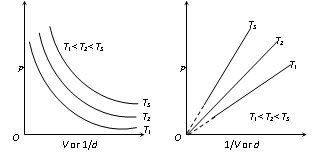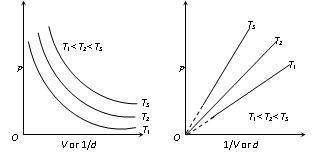Boyle's law
(1) In the year 1662, Robert Boyle discovered the first of several relationships among the gas variables (P, T, V).
(2) It states that, For the fixed amount of a gas at the constant temperature, the gas volume is inversely proportional to the gas pressure.
Thus,  at constant temperature and mass
at constant temperature and mass
or p = K/V (where K is constant)
or PV = K or P1V1 =P2V2 = K (For two or more gases)
(3) The Graphical representation of the Boyle's law: The graph between P and V at the constant temperature is called as isotherm and is an equilateral (or the rectangular) hyperbola. By plotting P versus 1/V, this hyperbola can be converted to the straight line. The other types of isotherms are also shown as follows,


(4) At the constant mass and temperature the density of the gas is directly proportional to its pressure and is inversely proportional to the volume of it.
Therefore, 
or 
(5) At the altitudes, as P is low d of air is less. That is why the mountaineers carry oxygen cylinders along with them.
Email based Chemistry assignment help - homework help at Expertsmind
Are you searching chemistry expert for help with Boyle's law questions? Boyle's law topic is not easier to learn without external help? We at www.expertsmind.com offer finest service of Chemistry assignment help and chemistry homework help. Live tutors are available for 24x7 hours helping students in their Boyle's law related problems. We provide step by step Boyle's law question's answers with 100% plagiarism free content. We prepare quality content and notes for Boyle's law topic under chemistry theory and study material. These are avail for subscribed users and they can get advantages anytime.
Why Expertsmind for assignment help
- Higher degree holder and experienced experts network
- Punctuality and responsibility of work
- Quality solution with 100% plagiarism free answers
- Time on Delivery
- Privacy of information and details
- Excellence in solving chemistry queries in excels and word format.
- Best tutoring assistance 24x7 hours